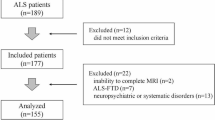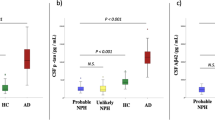Abstract
Objectives
Previous studies have shown possible choroid plexus (CP) dysfunction in Alzheimer’s disease (AD) and highlighted CP enlargement on magnetic resonance imaging (MRI) as a predictive factor of AD. However, few studies have assessed the relationship between CP volume (CPV) and mild cognitive impairment (MCI). In this large elderly population study, we investigated the changes in CPV in patients with MCI using MRI above 65 years.
Methods
This cross-sectional study included 2144 participants (median age, 69 years; 60.9% females) who underwent 3T MRI; they were grouped as 218 MCI participants and 1904 cognitively healthy controls. The total intracranial volume (ICV), total brain volume (TBV), CPV, hippocampal volume (HV), and lateral ventricle volume (LVV) were calculated.
Results
CPV/ICV was a significant independent predictor of MCI (p < 0.01) after adjusting for potential confounders (age, sex, hypertension, hyperlipidemia, diabetes, and education level). The CPV/ICV ratio was also a significant independent predictor of MCI after adjusting for the TBV/ICV ratio (p = 0.022) or HV/ICV ratio (p = 0.017), in addition to potential confounders. The CPV was significantly correlated with the LVV (r = 0.97, p < 0.01).
Conclusion
We identified a relationship between CPV and MCI, which could not be explained by the degree of brain atrophy. Our results support CP dysfunction in MCI.
Clinical relevance statement
Choroid plexus volume measurement may serve as a valuable imaging biomarker for diagnosing and monitoring mild cognitive impairment. The enlargement of the choroid plexus, independent of brain atrophy, suggests its potential role in mild cognitive impairment pathology.
Key Points
• The study examines choroid plexus volume in relation to cognitive decline in elderly.
• Enlarged choroid plexus volume independently indicates mild cognitive impairment presence.
• Choroid plexus volume could be a specific biomarker for early mild cognitive impairment diagnosis.

Similar content being viewed by others
Data availability
The health checkup data used in this study were collected from the Iwaki Health Promotion Project and transferred to a secure data center with restricted access controls in a de-identified format. The de-identified data are available from the Hirosaki University School of Medicine (contact via e-mail: coi@hirosaki-u.ac.jp) for academic research purposes only and for researchers who meet the criteria for access to the data. Researchers must be approved by the research ethics review committees of both the Hirosaki University School of Medicine and their affiliations. Three months were required for the access request to be approved.
Abbreviations
- AD:
-
Alzheimer’s disease
- CPV:
-
Choroid plexus volume
- GMV:
-
Total gray matter volume
- HC:
-
Cognitively healthy controls
- HV:
-
Hippocampal volume
- ICV:
-
Total intracranial volume
- LVV:
-
Lateral ventricle volume
- MCI:
-
Mild cognitive impairment
- MRI:
-
Magnetic resonance imaging
- TBV:
-
Total brain volume
- WMV:
-
Total white matter volume
References
Schmitter D, Roche A, Maréchal B et al (2015) An evaluation of volume-based morphometry for prediction of mild cognitive impairment and Alzheimer’s disease. Neuroimage Clin 7:7–17
Koikkalainen J, Lötjönen J, Thurfjell L et al (2011) Multi-template tensor-based morphometry: application to analysis of Alzheimer’s disease. Neuroimage 56:1134–1144
Park H, Yang J-j, Seo J, Lee J-m (2012) Dimensionality reduced cortical features and their use in the classification of Alzheimer’s disease and mild cognitive impairment. Neurosci Lett 529:123–127
Ma Z, Jing B, Li Y et al (2020) Identifying mild cognitive impairment with random forest by integrating multiple MRI morphological metrics. J Alzheimers Dis 73:991–1002
Damkier HH, Brown PD, Praetorius J (2013) Cerebrospinal fluid secretion by the choroid plexus. Physiol Rev 93:1847–1892
Benarroch EE (2016) Choroid plexus–CSF system: recent developments and clinical correlations. Neurology 86:286–296
Serot JM, Béné MC, Foliguet B, Faure GC (1997) Altered choroid plexus basement membrane and epithelium in late-onset Alzheimer’s disease: an ultrastructural study. Ann N Y Acad Sci 826:507–509
Choi JD, Moon Y, Kim HJ, Yim Y, Lee S, Moon WJ (2022) Choroid plexus volume and permeability at brain MRI within the Alzheimer Disease Clinical Spectrum. Radiology 304:635–645
Serot J-M, Béné M-C, Foliguet B, Faure GC (2000) Morphological alterations of the choroid plexus in late-onset Alzheimer’s disease. Acta Neuropathol 99:105–108
Silverberg G, Heit G, Huhn S et al (2001) The cerebrospinal fluid production rate is reduced in dementia of the Alzheimer’s type. Neurology 57:1763–1766
Tadayon E, Pascual-Leone A, Press D, Santarnecchi E (2020) Alzheimer’s disease neuroimaging initiative choroid plexus volume is associated with levels of CSF proteins: relevance for Alzheimer’s and Parkinson’s disease. Neurobiol Aging 89:117
Petersen RC, Stevens JC, Ganguli M, Tangalos EG, Cummings JL, DeKosky ST (2001) Practice parameter: early detection of dementia: Mild cognitive impairment (an evidence-based review)[RETIRED]: Report of the Quality Standards Subcommittee of the American Academy of Neurology. Neurology 56:1133–1142
McKhann G, Drachman D, Folstein M, Katzman R, Price D, Stadlan EM (1984) Clinical diagnosis of Alzheimer’s disease: report of the NINCDS-ADRDA Work Group* under the auspices of Department of Health and Human Services Task Force on Alzheimer’s Disease. Neurology 34:939–939
Ashburner J (2007) A fast diffeomorphic image registration algorithm. Neuroimage 38:95–113
Ashburner J (2012) SPM: a history. Neuroimage 62:791–800
Ashburner J (2009) Computational anatomy with the SPM software. Magn Reson Imaging 27:1163–1174
Shattuck DW, Mirza M, Adisetiyo V et al (2008) Construction of a 3D probabilistic atlas of human cortical structures. Neuroimage 39:1064–1080
Puonti O, Iglesias JE, Van Leemput K (2016) Fast and sequence-adaptive whole-brain segmentation using parametric Bayesian modeling. Neuroimage 143:235–249
Kanda Y (2013) Investigation of the freely available easy-to-use software ‘EZR’for medical statistics. Bone Marrow Transplant 48:452–458
Alisch JSR, Kiely M, Triebswetter C et al (2021) Characterization of age-related differences in the human choroid plexus volume, microstructural integrity, and blood perfusion using multiparameter magnetic resonance imaging. Front Aging Neurosci 13:734992
Jessen F, Amariglio RE, Buckley RF et al (2020) The characterisation of subjective cognitive decline. Lance Neurol 19:271–278
Edmonds EC, McDonald CR, Marshall A et al (2019) Early versus late MCI: Improved MCI staging using a neuropsychological approach. Alzheimers Dement 15:699–708
Dietrich MO, Spuch C, Antequera D et al (2008) Megalin mediates the transport of leptin across the blood-CSF barrier. Neurobiol Aging 29:902–912
Wen GY, Wisniewski HM, Kascsak RJ (1999) Biondi ring tangles in the choroid plexus of Alzheimer’s disease and normal aging brains: a quantitative study. Brain Res 832:40–46
Mawuenyega K, Sigurdson W, Ovod V et al (2010) Decreased clearance of CNS beta-amyloid in Alzheimer’s 384 disease. Science 330:385
Perl DP (2010) Neuropathology of Alzheimer’s disease Mount Sinai journal of medicine: a journal of translational and personalized medicine. J Trans Person Med 77:32–42
Li Y, Zhou Y, Zhong W et al (2023) Choroid plexus enlargement exacerbates white matter hyperintensity growth through glymphatic impairment. Ann Neurol. https://doi.org/10.1002/ana.26648
Hablitz LM, Nedergaard M (2021) The glymphatic system: a novel component of fundamental neurobiology. J Neurosci 41:7698–7711
Falahati F, Westman E, Simmons A (2014) Multivariate data analysis and machine learning in Alzheimer’s disease with a focus on structural magnetic resonance imaging. J Alzheimers Dis 41:685–708
Jovicich J, Czanner S, Han X et al (2009) MRI-derived measurements of human subcortical, ventricular and intracranial brain volumes: reliability effects of scan sessions, acquisition sequences, data analyses, scanner upgrade, scanner vendors and field strengths. Neuroimage 46:177–192
Wonderlick JS, Ziegler DA, Hosseini-Varnamkhasti P et al (2009) Reliability of MRI-derived cortical and subcortical morphometric measures: effects of pulse sequence, voxel geometry, and parallel imaging. Neuroimage 44:1324–1333
Zhou G, Hotta J, Lehtinen MK, Forss N, Hari R (2015) Enlargement of choroid plexus in complex regional pain syndrome. Sci Rep 5:14329
Acknowledgements
The authors thank all the investigators and participants of this study.
Funding
This study has received funding from AMED (Japan Agency for Medical Research and Development) under Grant Number JP16dk0207025.
Author information
Authors and Affiliations
Corresponding author
Ethics declarations
Guarantor
The scientific guarantor of this publication is Shingo Kakeda.
Conflict of interest
The authors of this manuscript declare no relationships with any companies whose products or services may be related to the subject matter of the article.
Statistics and biometry
No complex statistical methods were necessary for this paper.
Informed consent
Written informed consent was obtained from all subjects (patients) in this study.
Ethical approval
This study was conducted in accordance with the ethical guidelines of the Declaration of Helsinki, and the use of data from the Iki-Iki Health Promotion Project (Iki-Iki study) was approved by the Ethics Committee of Hirosaki University School of Medicine (authorization number 2019-064-1).
Study subjects or cohorts overlap
Subjects were fully overlapped with a previous study, “Association of prediabetes with reduced brain volume in a general elderly Japanese population,” in European Radiology, which investigated brain volume reduction in patients with diabetes. In this study, we investigate the choroid plexus volume in mild cognitive patients using the same cohort of participants.
Methodology
• retrospective
• cross-sectional study / observational
• performed at one institution
Additional information
Publisher's Note
Springer Nature remains neutral with regard to jurisdictional claims in published maps and institutional affiliations.
Rights and permissions
Springer Nature or its licensor (e.g. a society or other partner) holds exclusive rights to this article under a publishing agreement with the author(s) or other rightsholder(s); author self-archiving of the accepted manuscript version of this article is solely governed by the terms of such publishing agreement and applicable law.
About this article
Cite this article
Umemura, Y., Watanabe, K., Kasai, S. et al. Choroid plexus enlargement in mild cognitive impairment on MRI: a large cohort study. Eur Radiol (2024). https://doi.org/10.1007/s00330-023-10572-9
Received:
Revised:
Accepted:
Published:
DOI: https://doi.org/10.1007/s00330-023-10572-9




